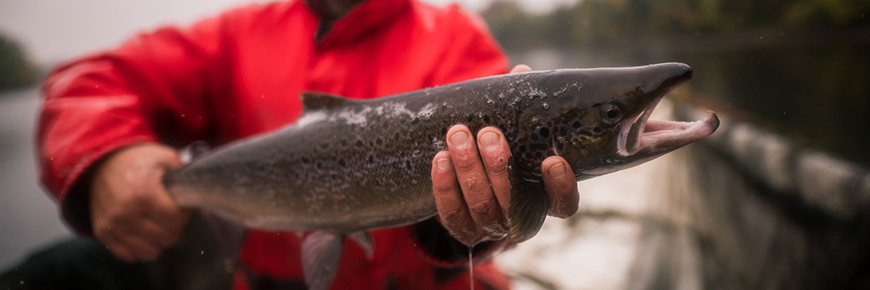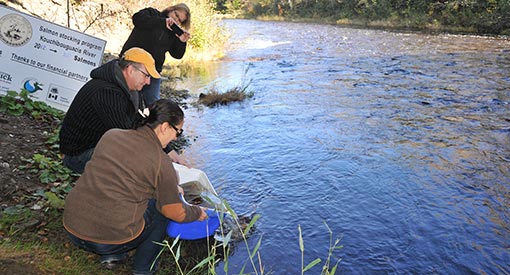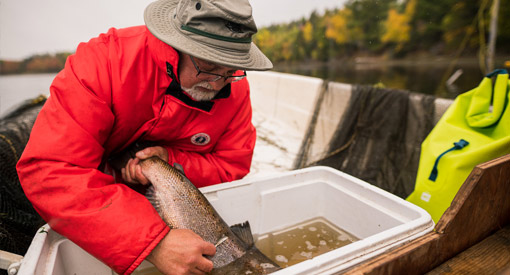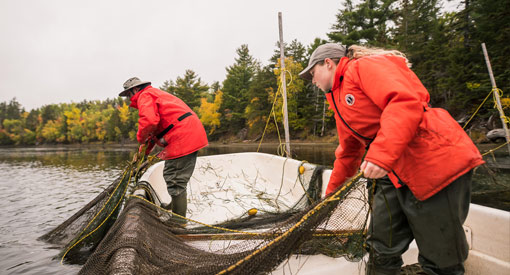
Atlantic Salmon: Return of the King
Kouchibouguac National Park
Salmon (Salmo salar)
In Mi’gmaq: Plamu
SARA Status: Special concern
Wild Atlantic salmon populations have undergone a widespread decline since the mid-1980s, mainly as a result of human activities such as overfishing and habitat destruction. The Gaspé – Southern Gulf of St. Lawrence population found in Kouchibouguac National Park is listed under COSEWIC as special concern since 2010 and a continuous decline in the number of adults returning to spawn in local watersheds is driving this population at risk.

These iconic fish, which are a significant cultural resource for First Nations communities and a prized catch for recreational fishers, continue to face numerous pressures such as climate change, by-catch from commercial fisheries, poaching, habitat degradation from activities outside Park boundaries, invasive species (e.g., smallmouth bass), and migration barriers (e.g., dams, culverts). However, the most substantial threats are presumed to ensue in ocean ecosystems therefore these pressures are compounded with low marine survival rates, resulting in further and faster population declines.
Parks Canada has been taking action to recover salmon stocks within national park sites for many years. In 2019, a five-year Conservation and Restoration (CoRe) project was funded in collaboration with other National Parks (Fundy, Cape Breton Highlands, Gros Morne, Terra Nova) and several partners to scale up salmon conservation efforts in the Atlantic region. The Kouchibouguac chapter aims to bolster knowledge, surveillance, and restoration of wild Atlantic salmon stocks in the Park’s river systems to increase abundance and resilience of our population, which in turn will contribute to the overall recovery of the species.

This new strategy will allow for information, research, and capacity sharing over a five year period.
The Kouchibouguac and Kouchibouguacis rivers stand out as two tributaries having considerable densities of juvenile salmon in the region, however, longer-term data show a declining trend overall.
In partnership with Indigenous communities and non-profit organizations (i.e., Les Amis de la Kouchibouguacis, Kopit Lodge, University of New Brunswick), we will utilize our knowledge and increase surveillance to manage restoration and monitoring efforts through habitat assessments, electro fishing surveys, adult trapping operations and genetic sampling. Each year, our Resource Conservation staff operate two smelt box nets to trap, count, and tag adult salmon in the park. Some healthy individuals are transported to a nearby hatchery for the production of fertilized eggs. With the help of non-governmental partner organizations, the park is involved in efforts to implant these fertilized eggs in suitable spawning habitat within park watersheds. Genetic samples are also taken from each captured adult to survey genetic diversity and verify the effectiveness of our conservation efforts. In addition, comparing the outcome of our monitoring and conservation efforts to that of other parks with varied salmon conservation status will help to understand the timeframe when actions applied to declining populations are most efficient.
Specific restoration and monitoring efforts include:
- Update and expand stream habitat inventories in six tributaries to increase knowledge of critical habitat used by Atlantic salmon in the Park’s river systems.
- Conduct electro fishing surveys to estimate juvenile salmon densities in these same tributaries.
- Operate two modified smelt box nets on the Kouchibouguac River to determine returning adult counts. This will also support and expand trapping operations in the Park’s region with partners on the Kouchibouguacis and Richibucto Rivers.
- Use specialized protective trays for the implantation and incubation of eggs generated from captured parents in order to maximize hatch and return rates from the release of these fry at two new sites within our river systems.
- Measure the success of our restoration efforts with the collection of genetic samples from parrs, smolts, and returning adults followed by parentage analyses to compare them with the genetic signature of our breeders; and also to document the genetic diversity of the salmon population.
Habitat
Atlantic salmon are a cold water migratory species that require different habitats for each life stage. They are born in freshwater, migrate to sea to feed and grow, and return to freshwater to reproduce or ‘spawn’.

The term anadromous refers to this type of migratory behaviour. While at sea, salmon remain in coastal areas or travel 2,500 km across the Labrador Sea to Greenland. Atlantic salmon returning to freshwater have an incredible ‘homing instinct’ that guides them back to the river where they were born. In freshwater, Atlantic salmon require clear, cold, fast moving water with a gravel bottom for spawning and rocky areas for juvenile fish. Salmon are often found in pools that offer protection from predators and warm temperatures and where water flow conditions enable them to rest.
Life cycle
- In late autumn, adult female salmon dig a shallow nest in the gravel called a redd. Eggs are laid in the redd and fertilized by male fish (anadromous or mature juveniles) in a process called spawning. The female salmon buries the fertilized eggs under 12-15 cm of gravel.
- Eggs remain buried in the gravel during the winter months and salmon hatch in early spring as alevins or yolk sac fry.
- Once the yolk sac is depleted, which takes about one month; alevins emerge as fry from the gravel to begin moving and feeding on their own.
- Toward the end of their first year, young salmon develop characteristic dark bars along their side with red spots distributed in between them and are referred to as parr. These markings help fish blend into their environment to avoid predators.
- At three or four years of age, parr change into smolts through a process called smoltification that allows them to survive at sea. Smolts migrate downstream and enter the sea in late spring or early summer (May/June). At this stage they are silver in colour and have dark fins, which reduces the risk of predation in open waters.
- After one to three years, salmon return to the river in which they were born to spawn. Salmon are classified by the number of years they spend at sea; one year are grilse or one-sea winter (1SW), two years are two-sea winter (2SW) and greater than two years are multi-sea winter (MSW).
- Salmon grow very quickly at sea due to plentiful food supplies. Grilse spawning for the first time are generally less than 63 cm in length (small salmon); whereas 2SW, MSW and repeat-spawning grilse are generally greater than 63 cm in length (large salmon). Most rivers in Newfoundland and Labrador are ‘grilse rivers’ and large salmon are predominantly repeat spawners.

Fun facts
- The salmon can leap up waterfalls of up to 4.5 metres high (15 feet), hence its scientific name, Salmo salar, which means “leaping salmon” in Latin.
- Atlantic salmon can travel up to 100 km per day in the ocean.
- Atlantic salmon lay 1,500 to 1,800 eggs per kilogram of body weight.
- Female Atlantic salmon build their nest (redd) and cover their eggs using their strong tail.
- Atlantic salmon scales can be ‘read’ much like the rings on a tree. The scales are used to determine the fish’s age, growth and how many times it has spawned.
- Fin tissue can be used to determine where Atlantic salmon were born.
- Date modified :